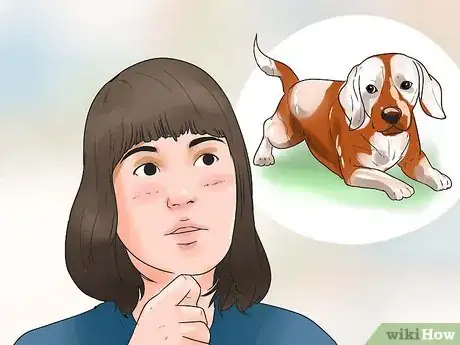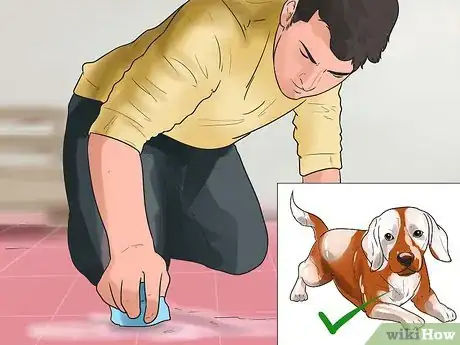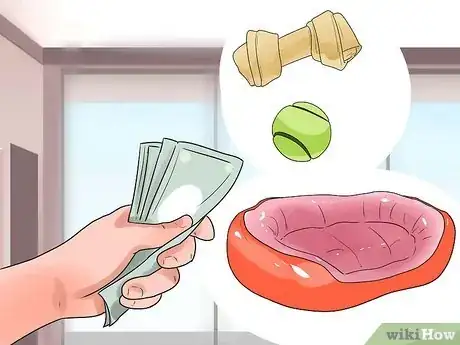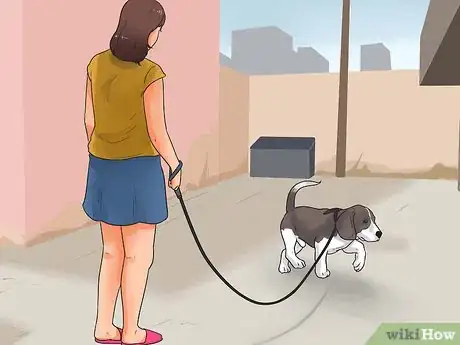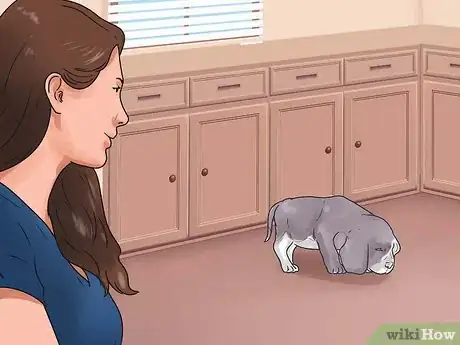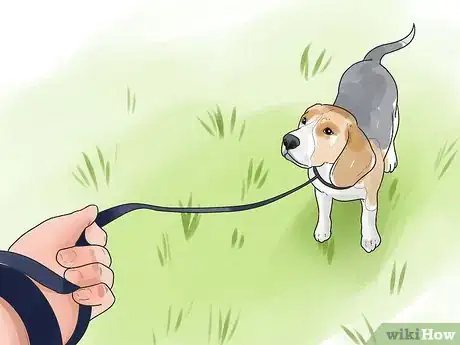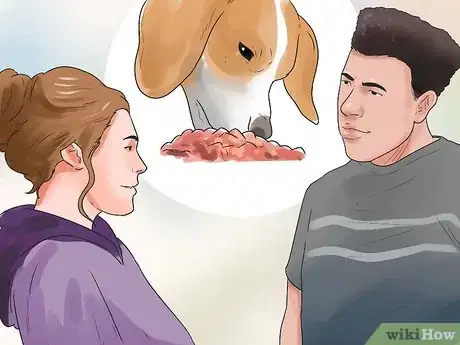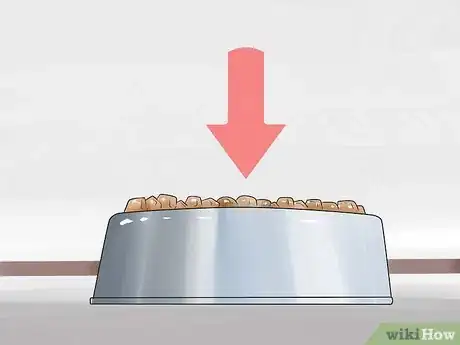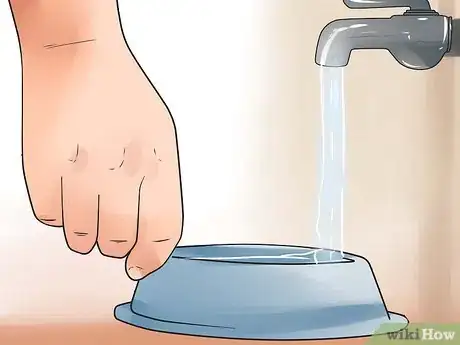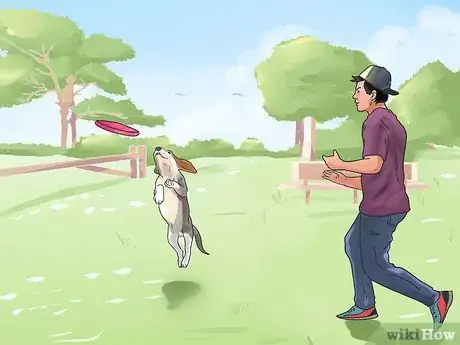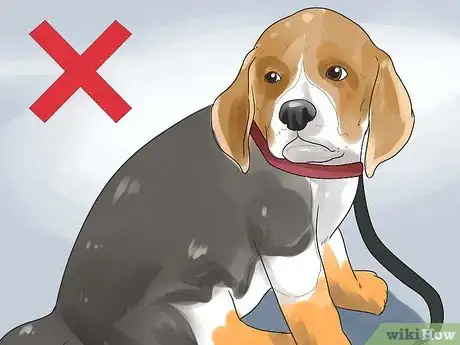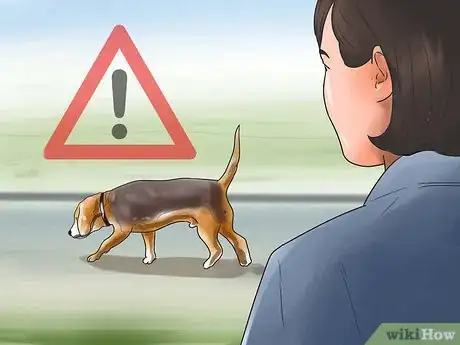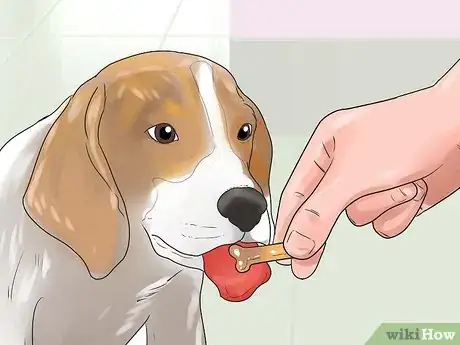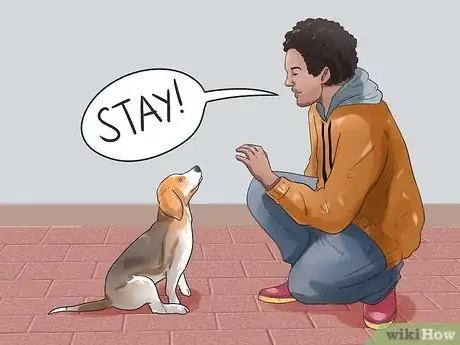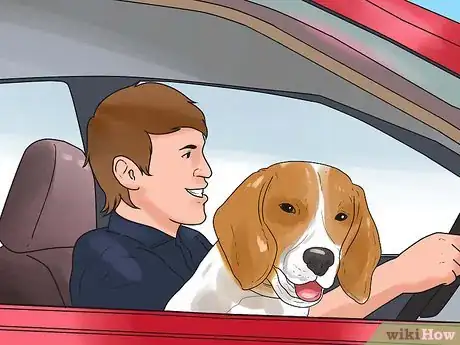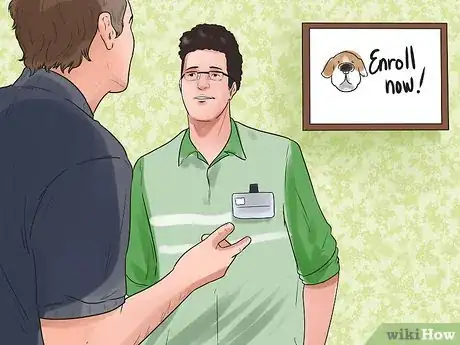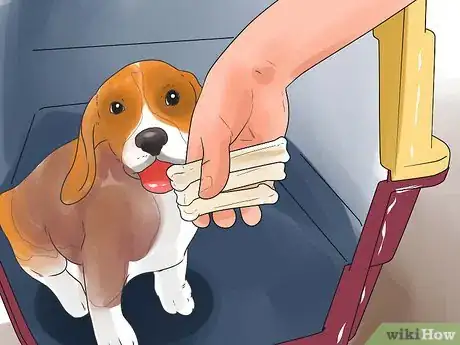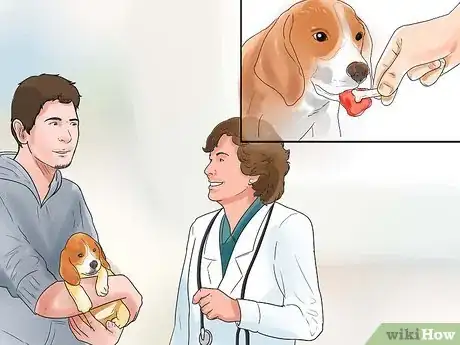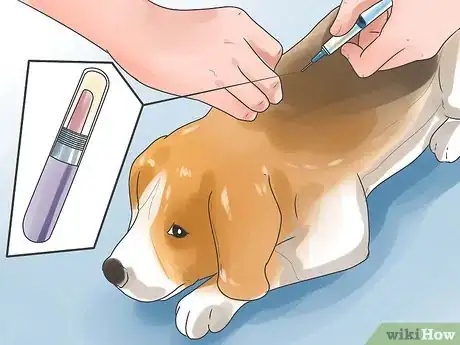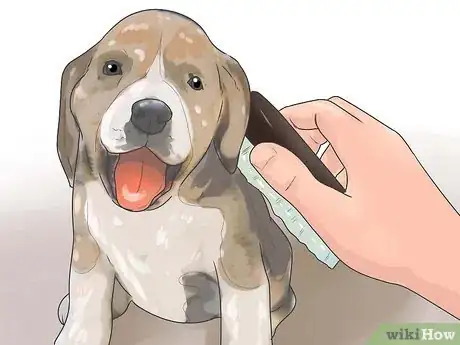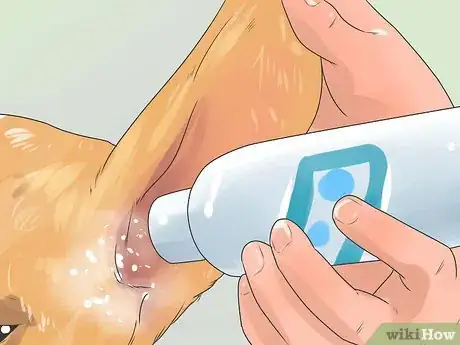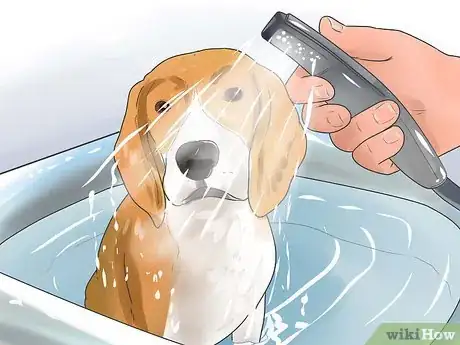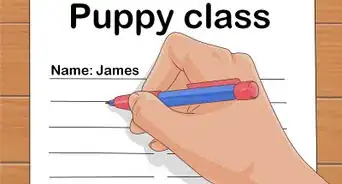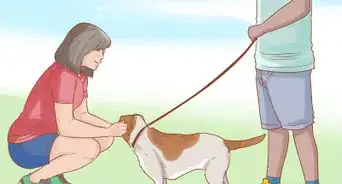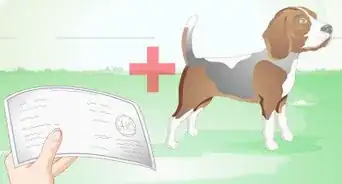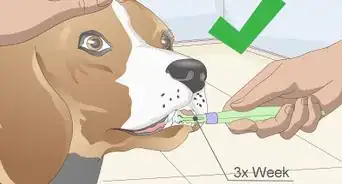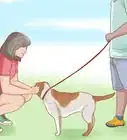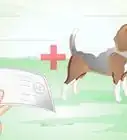This article was co-authored by David Levin. David Levin is the Owner of Citizen Hound, a professional dog walking business based in the San Francisco Bay Area. With over 9 years of professional dog walking and training experience, David's business has been voted the "Best Dog Walker SF" by Beast of the Bay for 2019, 2018, and 2017. Citizen Hound has also been ranked #1 Dog Walker by the SF Examiner and A-List in 2017, 2016, 2015. Citizen Hound prides themselves on their customer service, care, skill, and reputation.
wikiHow marks an article as reader-approved once it receives enough positive feedback. This article received 13 testimonials and 88% of readers who voted found it helpful, earning it our reader-approved status.
This article has been viewed 252,221 times.
Beagle dogs can be delightful pets but they do require a lot of training and care. Beagles are descended from working dogs, whose purpose was to hunt. This means they have a hard-wired instinct to run, sniff, and generally be active all day. Before you adopt a beagle puppy you need to be sure you can deal with their high level of energy.[1] Taking good care of a beagle puppy means you must commit to the giving the pup the exercise, attention, and mental stimulation that a beagle needs, in addition to the basic care every puppy needs.
Steps
Preparing to Bring a Puppy Home
-
1Know what to expect from a beagle generally. Keep in mind that a beagle is a hunting dog. When you understand how a beagle's mind works you can then make sure you put everything in place to satisfy your puppy's needs (mental and physical) so they grow up into a well-adjusted, content, and fulfilled adult dog. [2]
- For example, a beagle's hunting instincts means they are hugely inquisitive and will have their nose into everything whether it's their business or not.
-
2Puppy proof your house. Before bringing your puppy home, you should always make sure your house is "puppy proof." Pick up any garbage on the floor, personal items, food that is not for puppies or dogs, and other object that your puppy can swallow and/or choke on. Basically, it's essential to puppy proof the house because anything that isn't tidied away out of reach will be explored by the puppy's mouth and teeth.Advertisement
-
3Introduce yourself to the puppy. If you can't bring the puppy home right away, visit it often so that it will become comfortable around you. Many breeders will allow this, as it is good to get the puppy acclimated to you.
- Clearly this depends greatly on where and who you are adopting the puppy from. If you are adopting a puppy from a pound, for example, you should take it home quickly. If, on the other hand, you are adopting the puppy from a wonderful breeder, you should leave the puppy with its mother for as long as the breeder recommends.
-
4Buy supplies. Before bringing home a puppy you will need to get a lot of supplies. Here is a list to get you started:
- Food and water bowls: Bowls should preferably be stainless steel or ceramic, as these can be put in a dishwasher and the surface is easy to keep hygienically clean.
- A dog bed: The bed should be soft and snuggly, to help puppy feel safe. Choose one with a washable cover and consider getting two beds, so you can have one in the wash and one for puppy.
- Puppy pads: These are disposable absorbable pads that are useful for the inevitable toilet training accidents.
- Disinfectant and household gloves: These can be used for cleaning up after accidents. Choose an enzymatic cleaner and avoid those containing bleach or ammonia as this can amplify the scent of urine and inadvertently attract puppy back to that spot[3]
- A crate: Choose a crate that allows the beagle to stand up and lie with its legs outstretched. If the adult-sized crate is too big, devise a barrier to partition the crate to make it the correct size for the puppy. If a puppy has too much room it may use part of it as a bathroom area.[4]
- A collar and tag. Get a nylon collar and metal tag. The metal tag will be a good identifier if the puppy gets loose. Start using a collar at 6 months of age at the least. Remember when sizing the collar that puppies will grow.
- Harness and leash: It is great to get your puppy used to these from the start. They also help control the dog in the yard, so it doesn't run off when you are trying to toilet train it.
- Toys: Beagle puppies are avid chewers, so make sure all toys are certified as safe. Check toys regularly to see if they are damaged and discard if necessary. Remember stuffing, a toy's eye or nose, or even the squeaker inside could potentially cause a bowel obstruction if swallowed, so don't take that risk.
- Puppy treats: Make sure you get some soft and some crunchy treats. The crunchy treats will help clean tartar off your puppy's teeth, and the soft ones are good for using while training.
- Puppy food: Make sure you get the food it has already been eating if at all possible.
- Basic grooming tools: Get a bristle brush, comb, rubber gloves, nail clippers, dog shampoo, dog conditioner, dog toothpaste, toothbrush, and towels.
Bringing Your Puppy Home
-
1Take the puppy straight to a predetermined toilet spot when you bring it home. This is the place where you want it go to the bathroom. Pop the pup on the toilet spot and if it happens to squat down. If it does, give it lots of praise and a treat so that the puppy begins to associate that spot with the right place to go to the toilet.[5] [6]
- Walk your puppy around its new yard, and neighborhood before going inside. This will get it associated with the area and define its new territory.[7]
-
2Bring the puppy indoors but keep things low key. Don't go crazy and shower it will love just yet. You need to give it time to adjust to its new home. Have any kids sit quietly and let the puppy go to them, so that it doesn't feel overwhelmed. Remember to keep a close eye on the puppy and at the first sign of it sniffing to toilet pop it outside on the toilet spot, and reward it for going.[8]
-
3Keep the puppy on a leash and give it a tour of its new home. Once you bring your puppy home, show it around the house. This way the puppy will feel more comfortable knowing where everything is. This doesn't mean that you should let the puppy in every room right away, so just show it the rooms it will be allowed in.[9]
Feeding Your Beagle Puppy
-
1Ask the breeder for 4 - 5 days worth of the food the puppy has been eating. This is so it can eat something familiar that its tummy is used to digesting. Make a gradual change over to the food you select, once the puppy has had one or two days to get used to its new home.[10]
- To make this change add in a little of the new food (say ¼) and cut down on its previous diet (to ¾). Over 2 - 3 days further increase the amount of new food as you wean the puppy off the original diet. This gives the bugs in its tummy a chance to change over so that it doesn't get diarrhea because of a sudden change of food.
-
2Choose a food labelled as "Growth" or "Puppy" so that the youngster gets the right balance of calcium and protein for growth. Examine the label on the food packaging and check that a named meat, such as chicken, beef, or lamb, heads the list. This means the main ingredient is that named meat and is an indication of quality. Avoid foods which list cereals as the main ingredient and also "meat-by-products," since these are the less nutritional parts.
- Once puppy is a year old switch it onto adult food.
-
3Feed your puppy on a consistent schedule. For a puppy under 12 weeks of age feed the recommended quantity of food (as per the pack instructions) divided into 4 meals spaced over the day. For a puppy aged 3 - 6 months divide his daily allowance into 3 meals. For six months or over feed 2 meals a day.
- Once the puppy is one year old you have the option of feeding it just once a day.
-
4Don't give the puppy lots of extra treats or food. Remember that beagles are exceptionally greedy. The beagle has no concept of when it is full, so don't give into that appealing expression and give it extra food. Also, make sure all food is kept out of reach and in a sealed container, because your puppy will relish the challenge of finding a way to break into a food bin.[11]
- However, the good news is that beagles are highly motivated by food which gives you an excellent training tool.
-
5Take your puppy outside after eating. Be aware that after your puppy has eaten, approximately 10 - 20 minutes later, it will get the urge to toilet.[12] Put the puppy outside after a meal and remember to stay with it so that you are there to praise it when it goes.
-
6Wash your puppy's food bowls daily with warm water and a little dish soap. Or, just throw them in the dishwasher. Washing food bowls prevents illness, bacteria from growing, and it makes each mealtime more enjoyable.
Exercising your Beagle Puppy
-
1Give your puppy lots of gentle exercise. Beagles are energetic dogs that need plenty of exercise but be gentle with your growing dog's joints. The growing joint is more vulnerable to injury. To avoid this, much like an athlete warms up before a race, walk your puppy for 5 minutes before playing games of chase or fetch with it.[13]
-
2Don't exercise your puppy to the point of exhaustion. A good rule of thumb is never to exercise your puppy past the point where it drags itself along. If its muscles are tired, the puppy will stop supporting the joints. This is when it is most likely to injure its joints. If the puppy still has a spring in its step then you are OK.
- Be wary of over exercise until the puppy has reached its adult size, at 12 - 18 months of age.
-
3Walk your puppy on a short, 5-minute walk every day. Any more will make it too tired and hurt its joints. Exercise the puppy additionally by playing fetch or tugging on toys.
- Spend as much time as you can with your puppy. It won't be little for long, so take advantage of this time by playing and exercising with the puppy on a regular basis.
-
4Don't leave your puppy outside by itself. Your beagle puppy will not exercise itself as well as if you get involved with it. Also, beagles love to wander and explore by themselves. This means that an unattended beagle in the yard may worm its way through or under a fence and go exploring. They are first class diggers and climbers so never assume your fence is secure. [14]
- If your puppy truly can't escape be aware that frustration may cause the pup to bay or howl. Your best bet to prevent this is plenty of exercise and mental stimulation so that it is contentedly tired and doesn't feel bored or frustrated.
Training Your Beagle Puppy
-
1Start training your puppy early. The beagle's stubborn temperament makes it important to start training early so that it learns to listen to you. Incorporate training into everyday activities, such as getting the puppy to sit before putting its food down or putting its leash on. Keep actual training sessions short when puppy is very young, just 5 - 10 minutes when it is less than four months old.
-
2Use reward-based training. Don't punish your puppy. It will only associate the punishment with you (and become wary of you) rather than what it did wrong. Instead, give rewards when the puppy does something right. Be sure to give your puppy lots of love, attention and gentle guidance about good behavior.
-
3Train your puppy basic obedience commands. This will make your dog more enjoyable to be around in the long term. Begin by teaching your dog to sit. Then begin training the puppy to come when called and to stay on command. You will also want to start potty training the puppy the day you get it.
-
4Take your puppy on regular car rides to get it used to traveling with you. Otherwise, every time you get in the car it might think it is going to the vet. Then, the puppy will start whining and you will get frustrated.
-
5Socialize your puppy early. Bring it to a puppy obedience class once a week. This will help the dog learn how to act around unfamiliar dogs and people.
- However, don't expose your puppy to other dogs before it receives its vaccinations.
-
6Teach your puppy to be happy in a crate. The puppy with have a natural instinct to feel safe in a den and the crate becomes its go-to place to take time out and feel safe. Start by putting a blanket in the crate that smells of the puppy's mother, and also hide treats in the crate so that the puppy willingly goes and associates it with good things.
- Also, feed the puppy in the crate. At first feed with the door open. Once it goes in of its own accord, shut the door for a few seconds, open the door, and then praise the pup afterwards for being so good. Gradually build up the amount of time the door stays shut until you can leave the puppy for up to four hours at a time and it won't get distressed.[15]
- Leave a radio on for your puppy when not at home. This will make him feel safer.
Caring For Your Puppy's Health
-
1Get your puppy vaccinated. Schedule vet appointments for the proper vaccinations starting at 6-8 weeks of age. Your veterinarian will advise you about specific disease risks in your area and which diseases to vaccinate puppy against.
- Also discuss desexing with your vet so you can decide on what's best for your dog.
-
2Schedule a vet check-up for your puppy at least every six months. It's important to take your puppy to the vet regularly so that any problems can be spotted early. Caring for your puppy also means giving regular preventative healthcare treatments, such as heartworm, flea, and tick medications.
-
3Teach your puppy that going to the vet is an enjoyable (or at least tolerable) experience. Bring treats with you so you can give them to the puppy while you are there. If you take your puppy to the vet from an early age, it will get more used to the situation.
-
4Consider having a microchip implanted under your puppy's skin. This is a quick injection that inserts a small microchip into the skin. Each chip has a unique ID number which is registered against your details and is proof of ownership. This is especially appropriate for a beagle because if he escapes and goes walkabout, when he is handed into a dog pound they can scan the chip, find out who he belongs to and reunite you.
Grooming Your Beagle Puppy
-
1Groom your puppy every day. Use a bristle brush to remove shed hair and make its coat shine. Also include a dog-toothbrush and toothpaste in your grooming tools so that you can get the pup used to having its teeth brushed right away.
-
2Clean your puppy's eyes and ears. Clean its eyes daily to prevent infections and tear stains. Even breeds without white coats can get tear stains and inflammation of the skin around the eye. Clean ears bi-weekly to prevent wax and stink.
-
3Bathe your puppy when it gets dirty. Be careful to keep water temperature not too warm, and do not bathe your puppy too frequently. Frequent bathing will dry out its skin.
- Use a mild shampoo, such as a moisturizing oatmeal shampoo. Never use products designed for human use, as the pH of dog skin differs and the human shampoo will have an excessively drying effect.
Community Q&A
-
QuestionHow do I clean a puppy's ears?
 Community AnswerGo to your local pet store and ask for ear cleaning solutions. It is best to use them to clean your puppy's ears, so as to make sure that what you are using is harmless.
Community AnswerGo to your local pet store and ask for ear cleaning solutions. It is best to use them to clean your puppy's ears, so as to make sure that what you are using is harmless. -
QuestionHow energetic is a puppy beagle?
 Community AnswerAll puppies are energetic, but beagles are known for having an extreme amount of energy. Whenever they calm down, use the time to teach them to sit, look, and come.
Community AnswerAll puppies are energetic, but beagles are known for having an extreme amount of energy. Whenever they calm down, use the time to teach them to sit, look, and come. -
QuestionHow do I clean a beagle's eyes?
 Community AnswerUse a paper towel with a little lukewarm water added, then softly wipe the eye "boogers."
Community AnswerUse a paper towel with a little lukewarm water added, then softly wipe the eye "boogers."
Warnings
- Do not leave anything lying around that your puppy could choke on⧼thumbs_response⧽
- Do not train your puppy too late. It may become a HUGE problem if trained later. Start earlier!⧼thumbs_response⧽
- You should not buy a puppy younger than eight weeks old, as it should not be separated from its mother before that age.⧼thumbs_response⧽
References
- ↑ http://www.yourpurebredpuppy.com/reviews/beagles.html
- ↑ http://www.yourpurebredpuppy.com/reviews/beagles.html
- ↑ David Levin. Professional Dog Walker & Trainer. Expert Interview. 19 December 2019.
- ↑ David Levin. Professional Dog Walker & Trainer. Expert Interview. 19 December 2019.
- ↑ David Levin. Professional Dog Walker & Trainer. Expert Interview. 19 December 2019.
- ↑ The Happy Puppy Handbook. Pippa Mattinson. Ebury Press
- ↑ https://www.cesarsway.com/cesar-millan/cesars-blog/8-essential-steps
- ↑ The Happy Puppy Handbook. Pippa Mattinson. Ebury Press
- ↑ https://www.cesarsway.com/cesar-millan/cesars-blog/8-essential-steps
- ↑ The Happy Puppy Handbook. Pippa Mattinson. Ebury Press
- ↑ http://www.beaglepro.com/beagle-temperament
- ↑ David Levin. Professional Dog Walker & Trainer. Expert Interview. 19 December 2019.
- ↑ http://www.beaglepro.com/beagle-temperament
- ↑ http://www.yourpurebredpuppy.com/reviews/beagles.html
- ↑ The Happy Puppy Handbook. Pippa Mattinson. Ebury Press
About This Article
To take care of a beagle puppy, feed it a dog food that’s labeled either “Growth” or “Puppy” to ensure your new beagle gets the calcium and protein it needs to grow. When the puppy is under 12 weeks of age, divide its food into 4 meals a day, then reduce this to 3 meals from 3 to 6 months, and 2 meals after that. Beagles are very energetic dogs, so walk your puppy for at least 5 minutes once or twice a day, and increase this as it gets older. For tips from our veterinary reviewer on training your beagle, read on!
